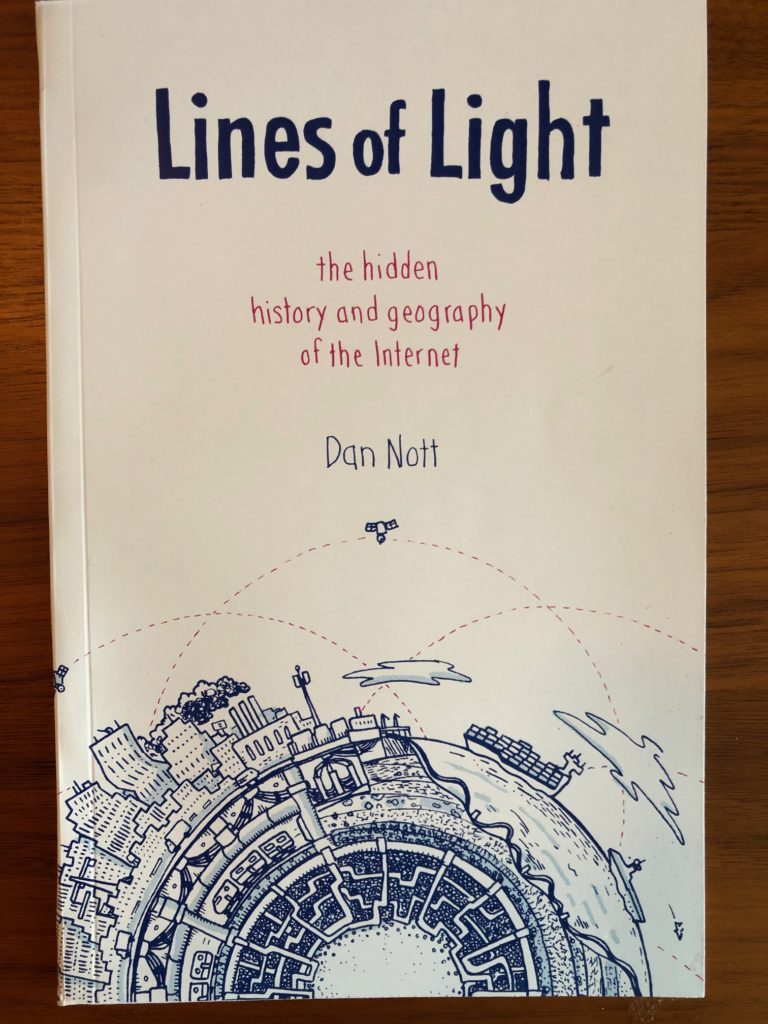
Lines of Light is a graphic novel by Dan Nott, which examines the “history and geography of the internet.” I was fortunate enough to meet the author at the Massachusetts Independent Comic Expo, which was held at Lesley University. This quarter I am teaching two courses on related topics (Digital Globalization as well as CyberWar and Espionage), so I was curious to view this work. This graphic novel is exceptional not only because it is visually engaging, but also because it takes a completely unexpected view of something that we all assume we understand. With his clear, concise prose to describe a physical world that we all rely upon, this book is filled with unexpected facts and insights.
One of the approaches that Nott takes is too look at how we use metaphors to talk about the internet, which can sometimes be misleading. The book starts with Senator Ted Stephens at the net neutrality hearing of 2006, where he tried too use a failed metaphor to describe the internet. From this moment, the work moves to consider more broadly how we all talk about the internet, and how accurate that language may be. While it might be easy to mock Senator Stephens, most of us also wrestle to describe something so abstract. Nott’s brilliance is being able to take these metaphors and place them into both a historical and a physical context, which is grounded by the detailed maps and imagery of the infrastructure that supports the internet.
Nott explores how we use metaphor by drawing on literature (William Gibson, of course), economic ideals, and our perception of other aspects of our infrastructure. What’s brilliant about the book is that he consistently contrasts our abstract ideas with images of the actual physical infrastructure and devices that to which we refer when we use our metaphors. As he points out, ‘the Cloud” is a wonderful image, but what it actually refers to is a data center, which he captures in illustrations that demonstrates its prosaic nature (42-45). Indeed, most of his illustrations detail the cables, computers, satellites, and technology that underpin the internet.
By the end of the book the reader has a much better understanding into not only the architecture of the internet, but also the history behind it. Indeed, as the work points out our current reliance on the Cloud is very much a return to the era of mainframes, which people would access through terminals. And although the internet appears ethereal, all that information is carried by a network of cables.
With his clear, concise prose to describe the physical world and its spare but beautiful imagery, this book makes fascinating reading. After finishing the work, I was left to wonder over the fact that when I publish this blog post, flashes of light in cables laid across the bottom of the ocean will take these words to others. I particularly loved a global map towards the middle of the work, which showed the network of these cables, the ships repairing them, the satellites that circled in space, and the redundancy of cables (p.22-25). Although this is a graphic novel (a term that may also be used for non-fiction works) this map is really a data visualization, which is brilliantly done. In the end I was perhaps most struck by the sheer amount of work that it must have taken to find this historical and contemporary information on the web and its antecedents; it’s not a trivial thing to locate historic maps of telegraph cables and then fiber optic cables. This short, insightful book builds upon an immense amount of research, so that it can take an incredibly complex topic and make it accessible. Highly recommended.
PS. If you are curious to view more of Nott’s work, you can find his Instagram account here.
